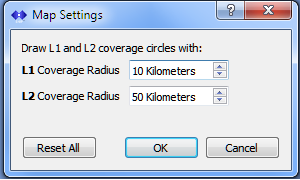What is new in the SNIP 3_09_00 release – released March 02 2023
(updating the prior release of 3_08 issued on December 28th, 2022)
This is the next production release of SNIP following the Rev 3_08 release. This release contains various major and minor improvements in response to user requests.
This release supports both 32-bit and 64-bit installations on all Windows Platforms from Windows 7 to the current editions. It is STRONGLY recommended that all Windows 32/64 SNIP installations now update to using this release.
Changes in this release include
Map Displays
A recent change in the Google Map API (with the release of Revision 3.52) caused all SNIP Casters to lose some basic map image abilities. The Maps for the WebAPI and some other reports using maps were not affected. This release overcomes that by forcing the use of an older version of the API. In addition, a number of other stock Java scripts have been updated to use current releases. Further details on this problem (and how to fix it by hand if you do not care to upgrade your copy of SNIP at this time) can be found at: https://www.use-snip.com/kb/knowledge-base/google-map-changes-updating/
A feature request to be able to control the radius used for the two transparent coverage circles drawn for “L1-Only” and “L1+L2” RTK coverage has now been implemented. Under the document viewer menu Window is a new item called Settings. When selected, a simple dialog box allows the operator to set the value for each in kilometers. Toggle the check boxes for L1 and/or L2 found in the Map Legend to see the new values. It should be stressed these limits are just for general information and the results seen by any individual rover will vary based on other environmental factors. As the saying goes, your mileage may vary.

Push-In Streams
A new feature allows adding an “alias” name to the Push-In reservations for a Base Station. This supports the unusual use case where the mountPt name of the Pushed-In Base cannot be controlled by the NTRIP Caster operator and another name is desired. A few reports now list both names when this feature is used.
All Non-reserved Push-In connections are now always given a unique indexing value. This overcomes a problem experienced in the last release (mostly by Lite model users) where only the first Non-reserved Push-In connections could be selected.
Push-Out Streams
The directional arrows used to indicate various stream types in other lists has been added to the list used in the Push-Out setup dialog.
Serial Streams
The baud rate 4800 has been added to the supported rates in the serial setup dialog.
P.F.A.T.
Corrected an indexing error in the PFAT Filter dialog where checking on an individual message type would result in another message type being incorrectly selected. The problem manifested itself when there were some messages in the Base Station data stream that were sent at very slow rates – when they arrived the prior list order was disturbed.
Misc. Improvements
- In-bound data rates displayed at the bottom of the SNIP window are now averaged over a rolling 10 second interval. This change was made to provide a more accurate average data rate. As a rule every GNSS Base Station sends out its observational messages at the top of each new second. This results in a burst of processing as every connected station hits the SNIP NTRIP Caster at that moment. This could periodically align with the label update rate on SNIP (an asynchronous process that is run every second) resulting in alternating large and small values. The new method mitigates this.
- SNIP now replies to any HTTP HEAD request with just the header portion of the NTRIP Rev2 Caster Table. This change was made to support various uptime robots that may probe the Caster seeking a HEAD reply. In a strict standards based sense, use of the HEAD verb is not defined by NTRIP. The correct reply would be to send back the entire Caster table. The current reply also supports the needs for NTRP Rev2 Clients who wish to examine the NTRIP flags indicating what options the Caster supports.
- When a valid email is required for the User Account to access the Caster (set under the Manage User Accounts dialog) and the eMail Plug-In is present, and the user has made a sufficient number of bad connections in a row, a warning email is sent out (as described here ). The email text used has now been improved to mention that a valid email account is expected from the user. And any SNIP-2-SNIP connections also receives these additional details in the reply.
- Entries in the connection summary report windows in the console (a Pro feature) have been improved to show the mountPt name and/or source URL for various bad connection entries.
How to Update…
Updates to SNIP are always free and easy. Your Caster will be offline about 3 minutes. From within SNIP, simply use the menu item Help ⇒ Check for Updates… Your update will be downloaded from our secure servers and then you will be asked to allow SNIP to restart and update itself. On some Windows 10 systems you must also manually exit the current copy of SNIP to update. That’s all there is to it!
